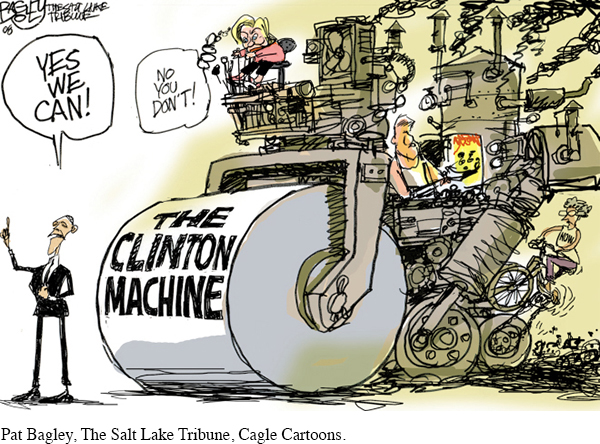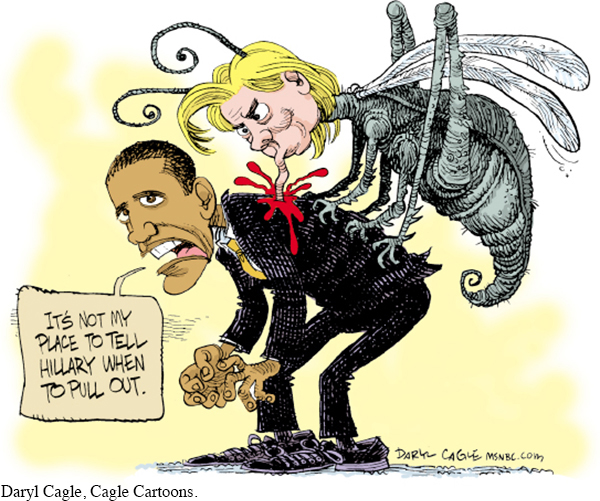ANALYZING HISTORICAL EVIDENCE: Caricaturing the Candidates: Clinton and Obama in 2008
ANALYZING HISTORICAL EVIDENCE
Caricaturing the Candidates: Clinton and Obama in 2008
In the Democratic presidential primaries of 2008, political cartoonists faced an unfamiliar challenge. As usual, cartoonists had to draw a recognizable image of a subject but exaggerate or enhance it to make it humorous. For the first time in a U.S. presidential primary campaign, a woman and an African American squared off as major rivals, upsetting centuries-old notions of who a president should be. Political cartoonists now faced the challenge of caricaturing a woman and a black man without opening themselves to charges of sexism or racism.
Hillary Clinton had a long history in political cartoons as First Lady and then as senator from New York. A favorite theme of cartoonists who commented on her active involvement in policy during her husband’s presidency suggested that she was exerting too much power rather than playing the traditional supporting role of First Lady. During her own campaign in 2008, cartoonists continued to exaggerate her hips, and they took advantage of the lines on the sixty-year-old’s face.
Political cartoonists drawing Barack Obama faced the challenge of avoiding obvious racial stereotypes. In contrast to Clinton, long in the public eye, Obama was a relative newcomer to the national scene, having spent just two years in the U.S. Senate before announcing his candidacy. Forty-seven years old, with a long, lean face and body and closely clipped hair, he provided fewer opportunities for caricature than did Clinton. Obama had already described himself as “a skinny kid with big ears and a funny name,” and cartoonists pounced on that image.
In the first cartoon, from February 2008, Hillary Clinton is in the driver’s seat of “The Clinton Machine,” which is about to crush Barack Obama. Note who is providing the power for the steamroller and how his appearance contrasts with that of Obama. Although Obama had won two of the four earliest primaries, the cartoonist suggests that Hillary Clinton’s campaign was about to clobber Obama. Consider what the cartoon suggests about Bill Clinton’s role in his wife’s campaign and about Hillary Clinton’s ambition.
Political cartoonists sometimes use animal images that have certain associations for their viewers. The second cartoon, showing Hillary Clinton as a wasp who will not let go of Obama, reflects the view of Obama supporters that Clinton should have pulled out of the race earlier. By May 2008, Obama had won the most delegates through state primaries. Yet Clinton hung on, claiming that she had won more of the overall popular vote and that she led Obama in support from the so-called superdelegates, including elected officials and party leaders, whose votes were not tied to primary election results. Even after her concession in early June 2008, some cartoons showed her threatening Obama as he contemplated choosing a running mate. This cartoon may have tapped into stereotypes of nagging women and into anxieties about an ambitious black man by making him appear weak and deferential.
Although cartoonists tended to portray Clinton and Obama as bitter enemies throughout the primaries, the two politicians began an effective partnership when president-elect Obama selected Clinton for the position of secretary of state in November 2008. [[LP Photo: P31.09 “The Clinton Machine”/

[[LP Photo: P31.10 “It’s Not My Place”/

Questions for Analysis
ANALYZE THE EVIDENCE: What is the effect of portraying Obama as oblivious to the Clinton machine’s power in the first cartoon and as unable to stand up to Clinton’s determination in the second? What stereotypes about women are conveyed in the ways in which Clinton is drawn in each of the cartoons? Would a man have been portrayed as a wasp?
RECOGNIZE VIEWPOINTS: What attitude about Bill Clinton’s role in his wife’s campaign is conveyed in the first cartoon? What message does the second cartoon send about Obama in showing Clinton seeming to overpower him, even though he was ahead of her in the race for the nomination? Do you think that these cartoonists successfully avoided sexist or racist stereotypes?
CONSIDER THE CONTEXT: In what ways was the election of 2008 groundbreaking?
Understanding the American Promise 3ePrinted Page 910
Section Chronology